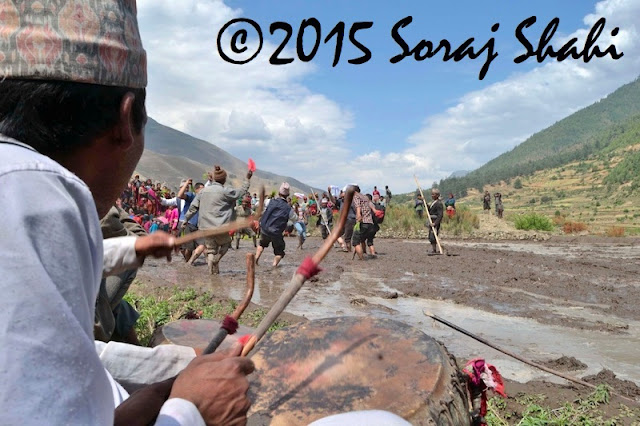17 June 2015
Ropai; The Rice Planting Festival
 |
| Chief District officer Mr.Dipendra Raj Poudel, planting rice plants |
District Agriculture Office,Jumla organised the
Rice Planting Festival in the historically important Laachu Jeuwla( Laachu
field prepared by the Lachal Kirti Paikalo; Lachhal Kirti, a famous ruler
and wrestler of the time and one of the disciples of the sage, cut the hillock
near Khala chour, a place between the villages of Micha and Sridhuska, to let
the water flow.) at Tatopani VDC. It lies
12km far from district headquarter Khalanga.
 |
| Rally of Festival |
The festival begins by planting rce plant by
the Chief District Officer ,Mr.Dipendra Raj Poudel and Liasion District Officer
Mr. Ishwori Kumari Giri with other senior officials from different Govt offices
and NGOs who attended the festival.
Rapoain
is a unique festival to observein Jumla.It is the highest place in world where
rice is cultivated. In Jumla before Monsoons starts the framers enjoy sowing
rice plants in their fields.The farming system in Jumla is still quite
traditional.
Government of Nepal started to celebrate Ropain
Festival from 2063 B.S. First of Asar is observed as Ropain Festival and Dhan
Festival in Jumla where as government of Nepal declare as 15 of Asar is a
Ropain Festival in all Nepal.
 |
| women dancing on the field |
The work of farming can be the fun of the
highest level and it can be observed during Ropai Festival in Nepal. Oxen
ploughing fields, women sowing seeds and farmers digging the fields and the fun
part of drenching each other with muddy water in the field are a great
enjoyment.
 |
| locally called Biyaray,helps to maintain the khet in a same level |
The traditional music fusioned with typical
Ropai songs sung by the farmers fill the atmosphere in the fields. The monsoon
festival related with agriculture and celebrated by the farmers these days is a
center of attraction in Jumla.
History of Paddy Cultivation
Kalo
Marsi;a special species of paddy suitable in high altitude and alpine climate
is grown in Jumla.
The marsi
grown in Jumla is considered as one of the Kashmiri varieties of paddy.
According to a local legend, a Kashmiri sage Chandan Nath on his way to
Mansarowar arrived at Jumla during thirteenth or fourteenth century. He meet (Lachal kirti paikalo; a powerful wrestler of the time later King of the
region) at Jumla. Valley was a big Lake.
He said here can be rice grown to Paikalo, later he opened way to pas the water
before Chandanath Baba came from Manasarowar, Lachhal Kirti had already
prepared the terrace of "Guru Phokto" (also called "Lachhu
Jyulo") near Tatopani, a perennial source of hot water.The Chandan Nath then returned to Kashmir from where he brought back paddy
seed of marsi.
Further
more; the Chandanath Baba taught the techniques to be adopted and the schedule
of activities to be followed in order to cultivate paddy. The people believe
that the god Chandan Nath originally prescribed the custom. This is therefore a
part of their religious duty to follow it as exactly as possible.
Calendar
of Rice Cultivation in Jumla practice
|
Date
|
Activities
|
|
Chaitra
12
|
Keeping
paddy seeds in water to moisten
|
|
Chaitra
16
|
Bringing
the moistend seeds and dry in sunlight. keep it near to warm place in Kitchen
to maintain wamth and ease to germinate
|
|
Chaitra
18
|
Seedling
in the seedbed locally called Bennu
|
|
Jestha
1-Asar first week
|
Uprooting
paddy seed and planting on the prepared field called Khet.
|
|
Asar(
June)
|
Weedinfg paddy ( once a month)
|
|
Shrawan
|
Weedinfg
paddy ( once a month)
|
|
Bhadra
|
On the day of Ganesh Chouthi, bring one tuft of paddy at home to offer to
the god Ganesh.
|
|
Kartik
|
Cutting,
threshing, winnowing and harvesting of paddy. From the first harvest, one Supa
of paddy, called shikh is offered to the sage Chandan Nath. But
these days few people only offered Shikh .
|
 |
| Planting of rice plants |
 |
| women planting rice plants and crowd watching a festival |







.JPG)
No comments:
Post a Comment